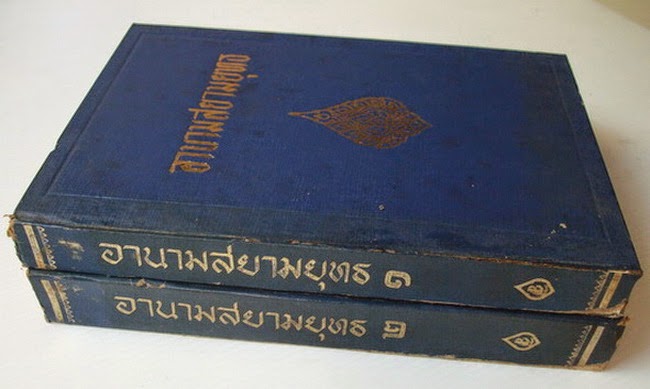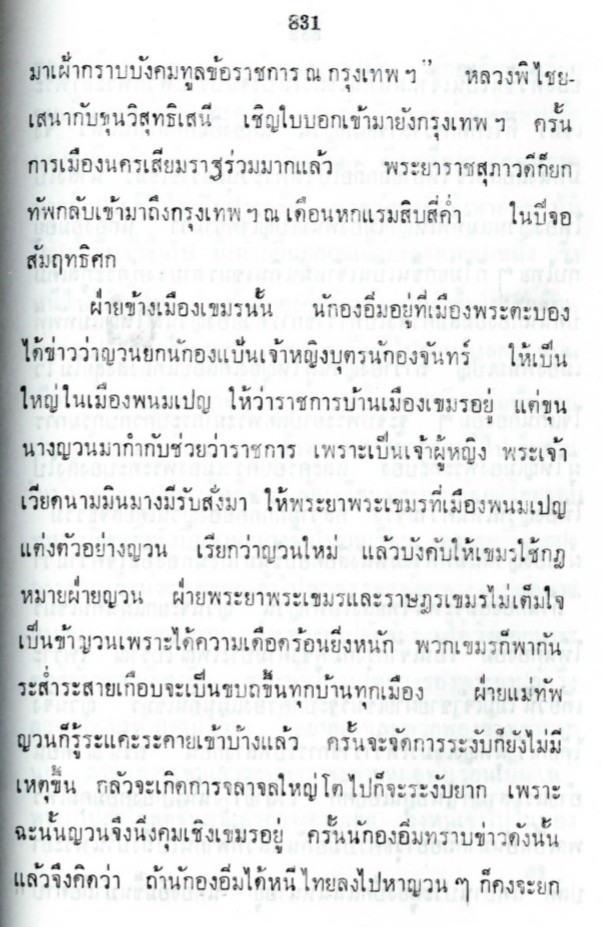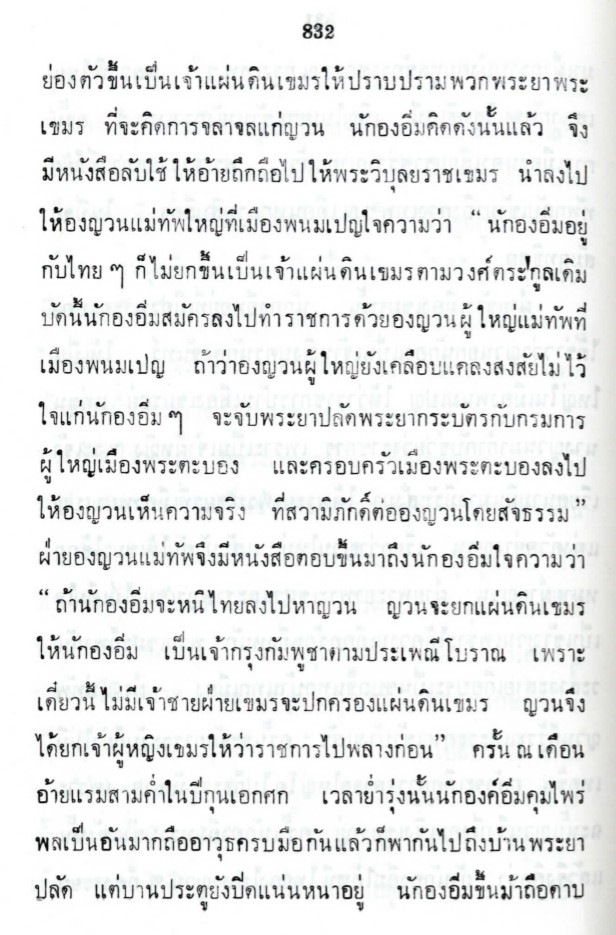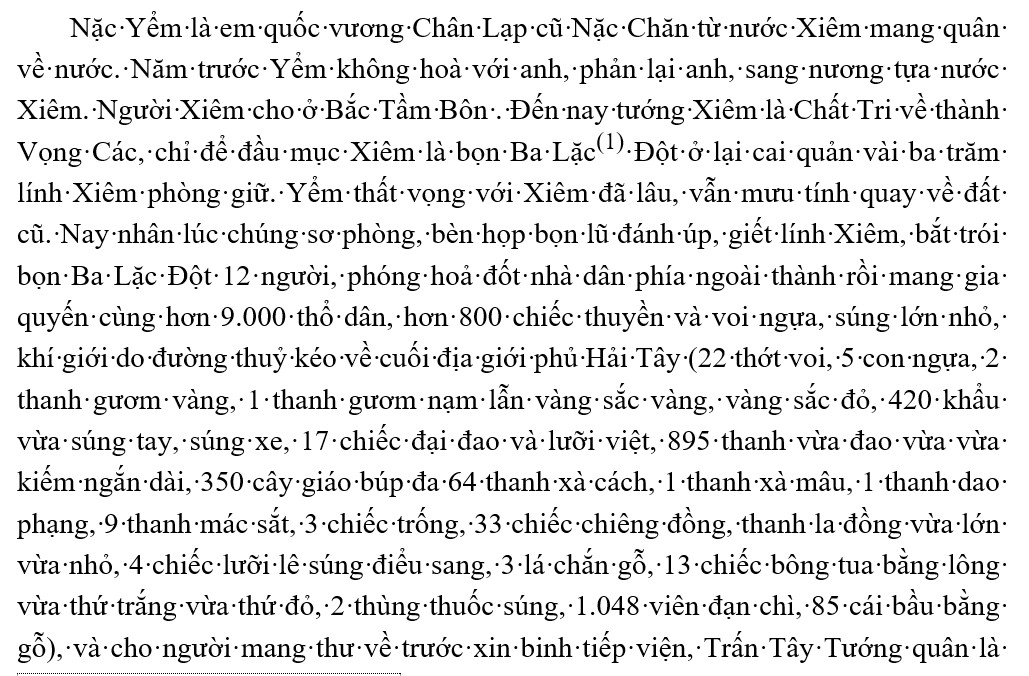Following up on the previous post, there is another source that mentions Cambodian officials and people wearing Vietnamese clothing – a Thai source known as The Battle between An Nam and Siam (Anam Sayam yut อานามสยามยุทธ).
This work was first published in 1907, and then republished in 1971, and was compiled by K. S. R. Kulap Kritsananon, a writer and publisher.
Kulap was a unique figure in that he was a commoner who wrote about history at a time when most historical writings were produced by people in the royal government. However, Kulap supposedly had access to the documents that had been earlier collected by Chao Phraya Bodindecha, one of the main Siamese military officials in the first half of the nineteenth century, and a figure who played a major role in the conflicts between Siam and the Nguyễn Dynasty at that time. (For more on this, see Craig Reynold’s “The Case of K.S.R.Kulap: A Challenge to Royal Historical Writing in Late Nineteenth Century Thailand.”)

In The Battle between An Nam and Siam Kulap has a passage in which the topic of Cambodian officials and people wearing Vietnamese clothes is mentioned. This passage is related to certain events that occurred in 1839.
One of the most important aspects about the history of this period is that throughout the first half of the nineteenth century the Cambodian royal family was divided, and at times had divided loyalties as well. King Chan, who ruled from 1806 to 1834, had two brothers, Duang and Im. They spent many years in Siam, while King Chan tried to maintain his control over Cambodia as a vassal of both Siam and the Nguyễn Dynasty.
King Chan died during the period of the Nguyễn Dynasty’s “annexation” of Cambodia, and the Nguyễn did not want either of Chan’s brothers to take his place as they were viewed as “pro-Siamese.”
King Chan had three daughters. The oldest, Princess Baen, was also considered by the Nguyễn to be “pro-Siamese,” but they allowed the second daughter, Princess Mei, to take the role as a figurehead for the kingdom.

This is what the situation looked like in the second half of the 1830s. Then in 1839, Im attacked the Siamese garrison in Battambang, where he was living, and captured its main officials. He then brought those officials into Cambodia and surrendered them and himself to the Nguyễn, along with thousands of people (from family members, to soldiers and commoners who had been ordered to support Im’s retinue).
Why did Im do this? According to the Đại Nam thực lục, Im got tired of being under Siamese control, and turned against the Siamese.
Kulap, meanwhile, offers a different explanation in his The Battle between An Nam and Siam.

Kulap records that while Im was in Battambong, “He heard that the Yuon [a term for “Vietnamese,” now considered derogatory] had appointed Princess Baen, the daughter of [King] Chan to be the head of the polity of Phnom Penh [“muang Phnom Penh”] and to let her rule over Cambodia [“muang Khamen”].
“However a Yuon nobleman came to direct and help in ruling since she was a princess.
“An order came from the leader of Vietnam, Minh Mạng, that the Khmer nobles in Phnom Penh dress like Yuon. They are called the ‘new Yuon.’ And the Khmer are forced to use Yuon laws.
“The Khmer nobles and people are not happy to be subjects of the Yuon because it causes serious hardship for them. Khmer spread across every village and town are on the verge of rebelling.” (831)

Kulap continues by stating that this gave Im the idea that if he was in control of Cambodia he could start a rebellion against the Vietnamese.
According to Kulap, Im then wrote a letter to the Nguyễn officials in Phnom Penh saying that he wanted to be the ruler of Cambodia, and that to show his sincerity to the Nguyễn he would deliver to them the top Siamese officials in Battambong as well as bring his and their families and followers.
Again according to Kulap, a Nguyễn official responded in a letter by saying that if Im fled from Siamese territory to Cambodia they would make him the ruler as there was no male member of the royal family in the kingdom, and that is why a princess was on the throne.

It is difficult to determine if any of this is true, but if it is, it again points to the fact that it was only Cambodian officials who wore “Vietnamese” robes. There was never an order issued that demanded that common people change the way they dress.
Although the information that Kulap records supposedly comes from something that Im “heard,” and therefore can’t be verified, it would make sense that the members of the Cambodian elite who were not collaborating with the Nguyễn (or whom the Nguyễn ordered be pushed aside as they had not fought against the Siamese – see the earlier post on this) would not like the members of the Cambodian elite who were collaborating with the Nguyễn.
And nothing represents that act of collaboration more clearly than the fact that the collaborating officials wore “Hoa” robes when they performed rituals with Nguyễn officials. If the term “new Yuon” did in fact exist at that time, it would have been used to refer to these collaborating officials by people who were not collaborating as it is clearly derogatory.
So it would make sense that this is something that members of the Cambodian elite who were not collaborating with the Nguyễn would think and say about those who were collaborating. And if there actually was some information like this that Im “heard” in 1839, that’s likely where it came from. People who were not in power wanted him to come and help them gain (or regain) power.


This Post Has 2 Comments
The term “yuon” reminded me of a conversation I had with somebody about the construction of Vĩnh Tế Canal; how accurate is the mistreatment of Khmer by Vietnamese in its construction? This is an issue that I often heard Cambodian brought up regarding Khmer-Vietnamese relation.
Thanks for bringing that topic up. I haven’t looked at it closely yet, but I will.